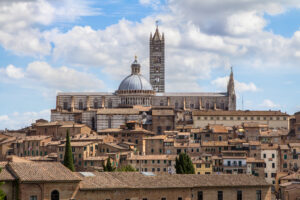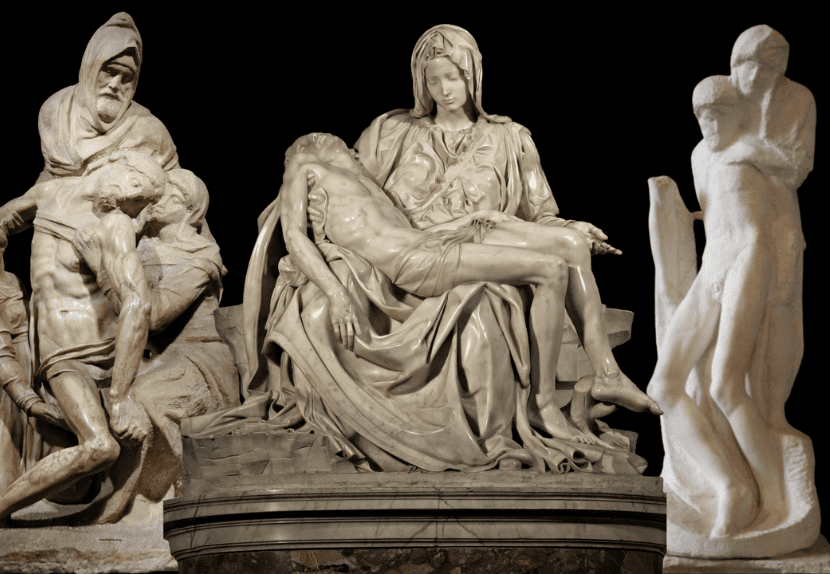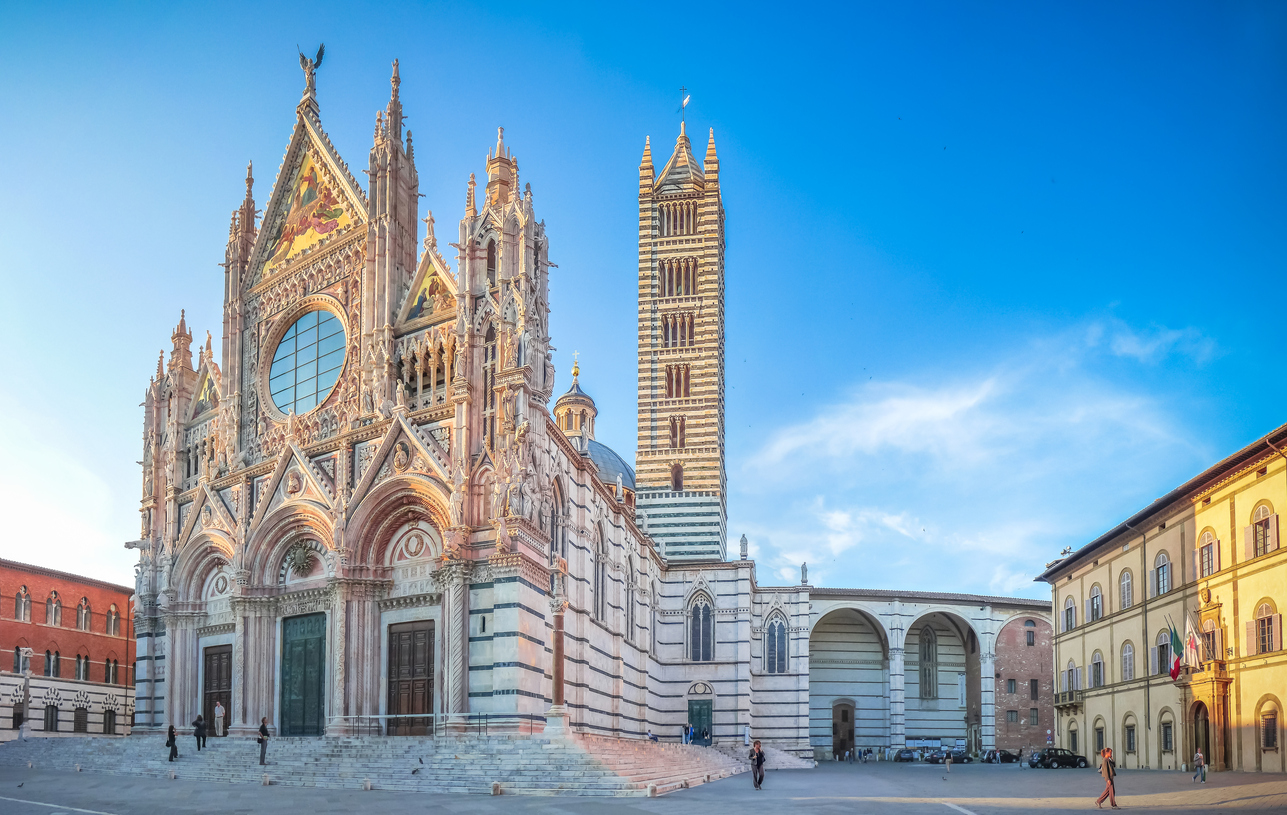
In 1226, the great medieval city-state of Siena commissioned the construction of a new cathedral atop the highest of the city’s 3 hills. (see below)
Following a longstanding Tuscan tradition (see Pisa, Lucca, San Gimignano, etc.), the new church was dedicated to Santa Maria dell’Assunta (St. Mary of the Assumption). Seventy years later, the church was nearing completion as work began on the façade of the building under the direction of the great Gothic sculptor Giovanni Pisano. (see below)

Siena Cathedral, 1226. By Globus.tut.by – Own work, CC BY-SA 4.0, https://commons.wikimedia.org/w/index.php?curid=61234556
Churches are normally built back to front, or altar to façade, because they typically take so long to complete (see Florence cathedral – 172yrs.; St. Peter’s – 121yrs.). Once the altar area was completed, masses could be celebrated while the rest of the church was still under construction. Thereby, if Pisano was made capomaestro della facciata, or “head master of the facade” in 1295, it is reasonable to conclude that construction was nearing an end.
After successfully seeing the construction of the cathedral through to completion, the Opera, or “building committee” now turned its attention to realizing another key component of a cathedral complex – the baptistery. Since Early-Christian times, baptisteries were usually located in front of a cathedral. (see below)
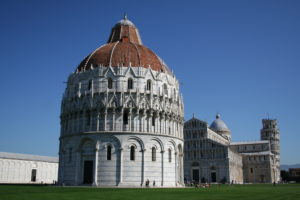
Pisa Baptistery and Cathedral, 1152 and 1063. By Massimo Catarinella – Own work, CC BY-SA 3.0, https://commons.wikimedia.org/w/index.php?curid=3635665
But in Siena, this solution was not possible due to the presence of a 13th-century hospital called Santa Maria della Scala and a portion of Europe’s most important pilgrimage road called the Via Francigena, both of which were located directly in front of the new cathedral. (see below)
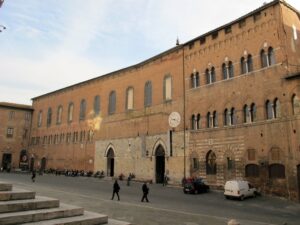
Hospital of Santa Maria della Scala, 13th century, Siena. By Sailko – Own work, CC BY 3.0, https://commons.wikimedia.org/w/index.php?curid=29268101
Millions of pilgrims passed through Siena each year on this medieval “Route 66” traveling from San Gimignano to Montalcino and towards their ultimate destination which was Rome. Full pilgrimage to Rome brought with it plenary indulgence, or full elimination of one’s purgatory time. Indulgence was the prime mover behind pilgrimage, and revenue was the prime mover behind indulgence. Revenue not only for Rome, but for all those cities fortunate enough to be located along the yellow brick road that lead to the eternal city.
As pilgrims passed by and marveled at the brand-new cathedral of Siena, they would be pleasantly surprised to discover that there was a “Motel 6” (see Hospital of Santa Maria della Scala) directly across the street where they could enjoy inexpensive lodging, food and medical care. Pilgrimage was indeed the ancestor of tourism.
Since the Opera could not build its baptistery in front of the cathedral, they decided to build it behind and below the church. Such a disposition also brought with it a new plan where the entire cathedral would be extended eastward atop the new baptistery that was carved out of the sandstone hill. A new eastern façade was also commissioned, although never completed. (see below)

Siena Baptistery, 1316-1325. By gaspa – Flickr, CC BY 2.0, https://commons.wikimedia.org/w/index.php?curid=6859751
Siena cathedral was extended from its original 71m/233ft. length to 81m/266ft. with the addition of a new choir above the baptistery. But why the need to enlarge the brand-new church? Because 62km north of Siena, the construction of a new cathedral was just beginning in the rival city of Florence.
Moreover, one of the earliest surviving documents concerning the construction of Florence Cathedral clearly states that the plan was “to build the largest cathedral in all of Tuscany”. Florence had taken aim at its two main rival cities of Pisa and Siena and was planning to supersize both of their cathedrals (for the historical antipathy between Tuscan cities, see past blog better a death in the family than a pisan architect on your doorstep). News of this plan must have reached Florence’s rival cities, and Siena was therefore taking preemptive competitive measures by enlarging its own cathedral. A 71m cathedral was already a significant scale for a medieval Italian cathedral. Surely 81m would more than suffice to compete with whatever Florence was planning. I mean, really, just how large could Florence Cathedral be….
>When the Siena Baptistery was completed in 1321, a group of local experts headed by the famed sculptor Lorenzo Maitani (see façade sculpture of Orvieto cathedral) was asked to assess the structural condition of the building. Maitani and his crew assured the Opera that the baptistery could sustain the weight of the overlying choir but suggested that the Opera not limit itself to a mere 10m addition.
Instead, they suggested that the Opera should build something more ambitious and appropriate for a city as noble as Siena. They suggested the construction of a Duomo Nuovo or a “new cathedral”!
The Opera’s response was predictable – NO WAY. They had just spent the last century and incalculable funds completing the present cathedral. Why would they possibly want to undertake a similar enterprise all over again, and on a larger scale to boot!!!! And so the proposal was given no further thought….
Then 17 years later in 1339, the Opera did an about face. The then-extant bell tower was demolished and the foundation stone for the Duomo Nuovo was laid! The only explanation for such an impetuous decision was that Siena now had a much-more-precise idea of the actual scale of the cathedral being built in Florence. And that scale was derived from the size of the bell tower in Florence begun 2 years earlier by Giotto. (see below) In other words, if the mere bell tower was going to be that big (92m tall), then just how large was the darn cathedral going to be!!!

Florence Cathedral Bell Tower, Giotto, 1334. By Dora Dragoni, CC BY 3.0, https://commons.wikimedia.org/w/index.php?curid=56862154
The “old” cathedral had been incorporated as the transept and choir of the new southward-extending nave, side aisles and south-facing façade (Facciatone). (see below)
Within 9 years, the Duomo Nuovo was nearly completed. A new façade, the interior revetment and decoration were all completed. The nave and side aisles were not only completed, but partially vaulted as well, and vaulting is usually realized in the last stages of construction. (see below)
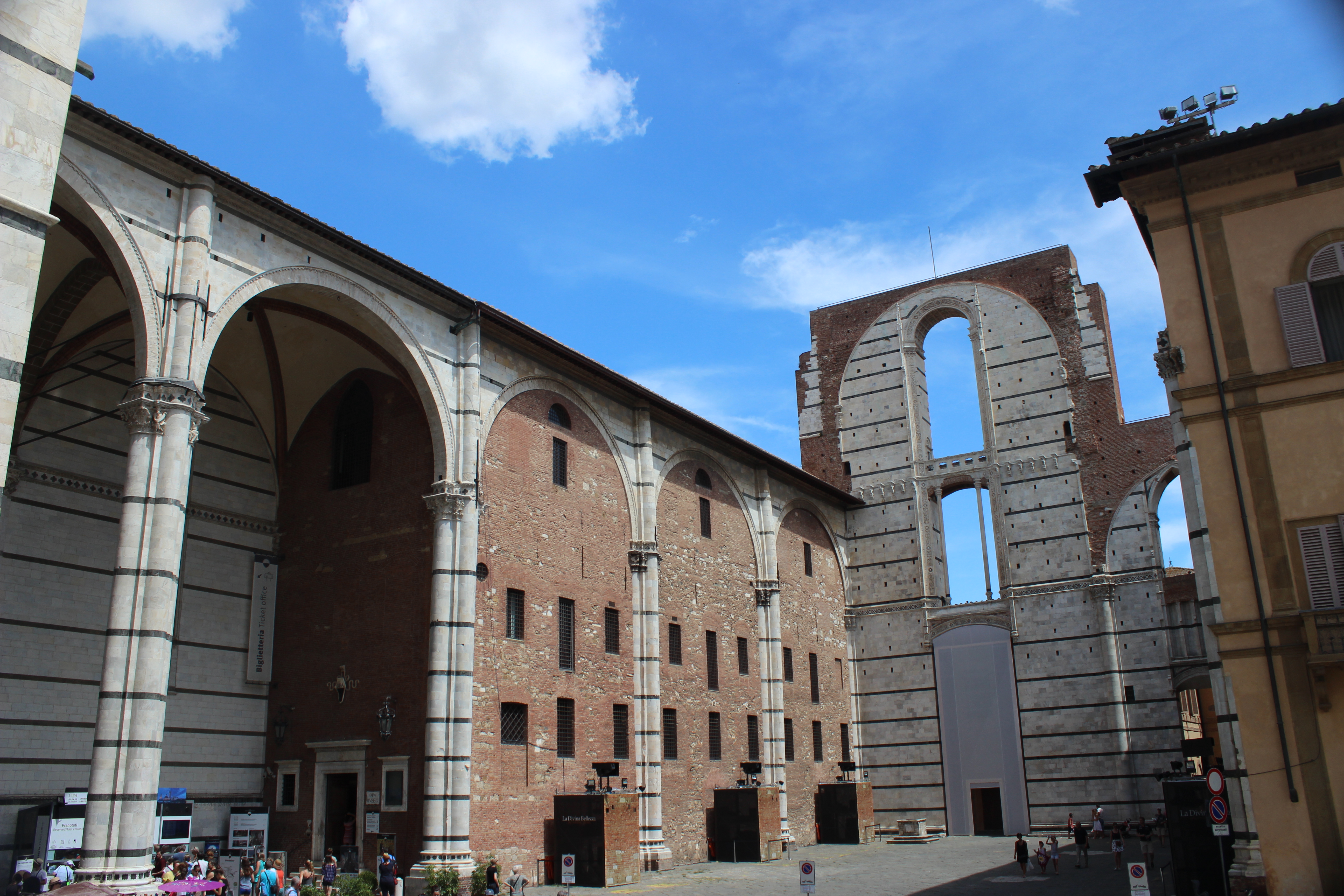
Duomo Nuovo, Siena. Di Miguel Hermoso Cuesta – Opera propria, CC BY-SA 4.0, https://commons.wikimedia.org/w/index.php?curid=45047977
But a minor catastrophe called the “Black Death” brought the whole project to a screeching halt! To put it simply, the Sienese (like the rest of Europe) were too busy dying to build. While 1/3 of Europe’s population fell victim to the “mother of all plagues”, Siena’s fatality rate was closer to 50%. An urban population of 60,000 souls fell to 30,000. But the most frightening statistic is that the population of Siena today (in 2018) is 60,000! It has taken the city seven centuries to get it demographic levels back to those previous to the Black Death…
When the dust finally began to settle after this apocalyptic epidemic, Siena turned its attention once again to finalizing its gigantic new cathedral. But structural difficulties lead to the Opera inviting a group of Florentine architects to come and assess the project. Why the Sienese would invite Florentine architects can only be explained by the obvious scarcity of architects in general.
And what advice would Florentine architects give to a Sienese Opera about to finalize the construction of the largest church in the Christian world – FORGET ABOUT IT!
The Florentines, led by an architect named Francesco Talenti, claimed that the Duomo Nuovo was both a structural, and therefore, economic, disaster waiting to happen. They advised abandoning the project and, at most, enlarging the original 13th-century cathedral. Now, the Sienese were not the gullible. They deliberated for a full 2 years, but ultimately took the Florentine advice and began to tear down the vaults and other parts of the new cathedral.
Had the Duomo Nuovo been completed, it would have measured 140m/460ft. in length, making it by far the largest church in Christendom. Instead, after abandoning and demolishing much of the building, it stands today as an architectural carcass (not to mention historically-significant parking lot) in the center of Siena. (see below)
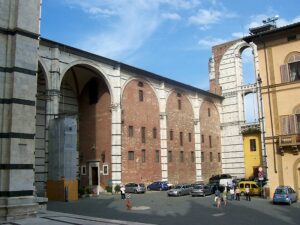
Duomo Nuovo, Siena. Di MarkusMark – Opera propria, Pubblico dominio, https://commons.wikimedia.org/w/index.php?curid=7123994
But the story does not end here… After successfully convincing the Sienese to abandon their project, Francesco Talenti returned to Florence and was offered the head architect position of the cathedral bell tower (a coincidence I’m sure). He completed the project in just 2 years. Several years later, he was made capomaestro of the entire cathedral. His most influential decision was to enlarge Florence cathedral from its original Arnolfian scale to its present length of 152m/499ft., making it by far the world’s largest Christian church. But more importantly, he gave Florence a 12m cushion in size, so that had the Sienese decided to carry out their Duomo Nuovo (which they still could, considering how much of it still stands) Florence cathedral would still be larger. This of course proves once again that the most important rule in architecture is that MINE IS BIGGER THAN YOURS!! (see below)



